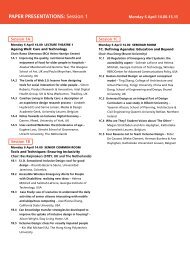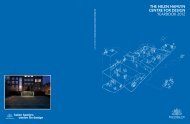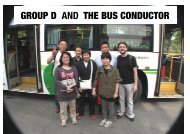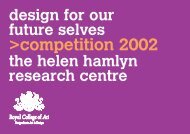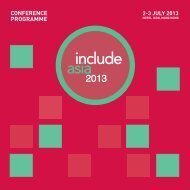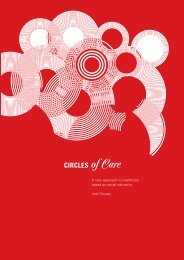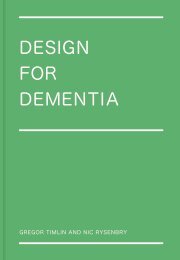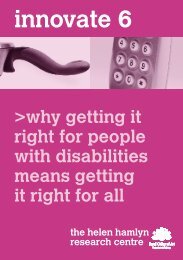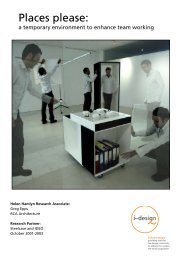When fashion meets discretion - Royal College of Art
When fashion meets discretion - Royal College of Art
When fashion meets discretion - Royal College of Art
Create successful ePaper yourself
Turn your PDF publications into a flip-book with our unique Google optimized e-Paper software.
<strong>When</strong> <strong>fashion</strong> <strong>meets</strong> <strong>discretion</strong><br />
Graham Pullin, School <strong>of</strong> Design and School <strong>of</strong> Computing, University <strong>of</strong> Dundee,<br />
Dundee DD1 4HT, United Kingdom, g.pullin@dundee.ac.uk, +44 1382 386531<br />
abstract<br />
Design for disability has traditionally seen its role to restore ability as discretely as<br />
possible. This has resulted in decades <strong>of</strong> pink plastic aids and miniaturised devices<br />
designed to be camouflaged or hidden: to go unseen.<br />
Yet glasses are an exemplar <strong>of</strong> design helping to reduce any stigma associated with<br />
a disability, and have achieved this not through invisibility, but through good design<br />
defined in more subtle terms. Fashion sensibilities have been pivotal to this success,<br />
as has the adoption <strong>of</strong> glasses as <strong>fashion</strong> accessories: a move from vision correction<br />
to 'eyewear'.<br />
This paper contrasts hearing aids and prosthetic limbs that have not made this<br />
transition. These industries have yet to engage all the required skills, but more<br />
importantly the culture and spirit <strong>of</strong> <strong>fashion</strong>. They would benefit by involving <strong>fashion</strong><br />
designers in particular, and more diverse and extreme designers in general.<br />
This will be challenging, as it implies embracing values that some in design for<br />
disability and inclusive design may feel squeamish about: not always valuing<br />
<strong>discretion</strong> above all things; seeing design as more than problem solving; being<br />
prepared to <strong>of</strong>fend and court controversy at times. But these are healthy tensions<br />
and should be welcomed!<br />
<strong>fashion</strong> and <strong>discretion</strong><br />
The priority for design for disability has traditionally been to restore ability without<br />
attracting attention. Medical-looking devices moulded from pink plastic are an<br />
attempt to camouflage them against the skin. The approach has been less about<br />
projecting a positive image as about trying not to project an image at all.<br />
But this priority can be challenged. Might it send out a signal that disability is after all<br />
something to be ashamed <strong>of</strong>? If <strong>discretion</strong> were to be removed as a priority, what<br />
would take its place? Invisibility is relatively easy to define and may even be<br />
achieved through technical and clinical innovation. It is more difficult to define a<br />
positive image purely from these perspectives.<br />
Fashion on the other hand might be seen as being largely concerned with projecting<br />
an image. Making the wearer look good to others and feel better about themselves.<br />
Eyewear is a market in which <strong>fashion</strong> and disability have been combined. On the rare<br />
occasions that the words ‘design’ and ‘disability’ are mentioned in the same breath,<br />
glasses are <strong>of</strong>ten referred to as the exemplar <strong>of</strong> a product that addresses a disability<br />
yet with little or no social stigma attached. A positive image for disability has been<br />
achieved without invisibility.<br />
1
Fashion and <strong>discretion</strong> are not opposites <strong>of</strong> course: <strong>fashion</strong> can be understated;<br />
<strong>discretion</strong> does not require invisibility. Nonetheless there is a tension between these<br />
qualities because they cannot both be the absolute priority. There are also deep<br />
cultural tensions between the two design communities. Perhaps <strong>fashion</strong> with its<br />
preoccupation with an idealised human form is seen as having little to say about<br />
diversity and disability. The extremes and sensationalism <strong>of</strong> cutting edge <strong>fashion</strong> can<br />
seem inappropriate in the context <strong>of</strong> disability, where <strong>discretion</strong> is seen as being so<br />
important. For some in the medical field, the very notion <strong>of</strong> <strong>fashion</strong>, <strong>of</strong> designs<br />
coming and going, is the antithesis <strong>of</strong> good design.<br />
But learning from <strong>fashion</strong> might require embracing not only its design qualities but<br />
also more <strong>of</strong> its values. Fashion does not just arise from a particular set <strong>of</strong> skills, but<br />
from a culture. The mechanism through which <strong>fashion</strong> design evolves, through the<br />
avant garde <strong>of</strong> haute couture and street <strong>fashion</strong>, creates extreme designs that can<br />
provoke negative as well as positive reactions in different audiences. It may not be<br />
possible to have one without the other, the results without the culture and the values.<br />
This paper will consider the way that spectacles have evolved from medical products<br />
to <strong>fashion</strong> accessories, reflecting on how this might inform the design <strong>of</strong> other<br />
products. In the case <strong>of</strong> hearing aids looking at a recent initiative to inspire design<br />
research; in the case <strong>of</strong> prostheses to anticipate such engagement in the future.<br />
glasses<br />
These days, glasses or spectacles are <strong>of</strong>ten held up as an exemplar <strong>of</strong> design for<br />
disability. The very fact that mild visual impairment is not commonly considered to be<br />
a disability, is taken as a sign <strong>of</strong> their success. But this has not always been the<br />
case.<br />
Lewis [1] has charted their progress from medical product to <strong>fashion</strong> accessory. In<br />
the 1930's in Britain, National Health Service spectacles were classified as 'medical<br />
appliances', their wearers as 'patients'. It was dictated that "medical products should<br />
not be styled". In the 1930s glasses were considered to cause social humiliation, but<br />
the health service maintained that their glasses should not be 'styled' but only<br />
'adequate'. In the 1970s the government acknowledged the importance <strong>of</strong> styling, but<br />
maintained a medical model for their own NHS spectacles in order to limit the<br />
demand. In the meantime, a few manufacturers were <strong>of</strong>fering <strong>fashion</strong>able glasses to<br />
consumers who could afford them. Lewis considers that the real breakthough came<br />
in 1991, when the design press declared that "eyeglasses have become stylish." [2]<br />
These days, <strong>fashion</strong>able glasses are available in the High Street. It has been<br />
recorded that up to 20% <strong>of</strong> some brands <strong>of</strong> glasses are purchased with clear nonprescription<br />
lenses, so for these consumers at least wearing glasses has become an<br />
aspiration rather than a humiliation.<br />
So what lessons does this have for design and disability? Several, especially in<br />
relationship to the widely held belief that <strong>discretion</strong> is the ultimate priority in any<br />
design for disability:<br />
Firstly, glasses do not owe their acceptability to being invisible. Striking <strong>fashion</strong><br />
frames are somehow less stigmatising than the National Health Service ‘invisible’<br />
pink plastic glasses prescribed to schoolgirls in the 1960’s and 70’s. Attempting<br />
camouflage is not the best approach and there is something undermining about<br />
invisibility that fails: a lack <strong>of</strong> self-confidence that can communicate an implied<br />
2
shame. It is significant that glasses continue to coexist with contact lenses, which do<br />
<strong>of</strong>fer complete invisibility.<br />
But neither is the opposite true: glasses’ acceptability does not come directly from<br />
the degree <strong>of</strong> their visibility either. Brightly coloured frames exist, but are still a<br />
minority taste. This might serve as a caution to medical engineering projects that<br />
have adopted a bright colour schemes for medical products 'to make a <strong>fashion</strong><br />
statement’ as the automatic progression from making a product flesh-coloured.<br />
Most spectacle design, and design in general, exists in the middle-ground between<br />
these two extremes. This requires a far more skilled and subtle approach, one that is<br />
less easy to articulate than these extremes. Designers <strong>of</strong>ten use the term ‘materiality’<br />
to describe the inherent aesthetic qualities <strong>of</strong> different materials. Materiality is hugely<br />
important to design in general, and to spectacle frames in particular, yet is so<br />
frequently absent outside a design culture. Manufacturers such as Alain Mikli [3] are<br />
perpetually exploring new combinations <strong>of</strong> laminations, translucency, colour and<br />
decorative texture (Figure 1 i & 1 ii).<br />
And the most elegant frames can be let down by a badly resolved hinge detail, or the<br />
way a nose bridge <strong>meets</strong> the frame. Everything is on display and contributing to the<br />
whole. Everything must be visually resolved, an attention to detail that is demanding<br />
even to the best designers.<br />
eyewear<br />
Spectacles have become ‘eyewear’ and this term encapsulates a number <strong>of</strong><br />
important perspectives, perspectives currently missing from much design for<br />
disability. You ‘wear’ glasses rather than carry them or just ‘use’ them. Somehow, the<br />
term ‘user’ becomes inappropriate. ‘Wearer’ sets up a very different relationship<br />
between designer and the person being designed for.<br />
Of course glasses are not designed as products in isolation, but in relation to the<br />
body, and the most personal part <strong>of</strong> the body at that. This makes glasses’<br />
acceptability all the more impressive, and encouraging. They frame not only their<br />
own lenses, but more importantly our face, our eyes and our glances. With this<br />
comes the risk <strong>of</strong> a design not suiting a particular individual, or they not liking it, and<br />
so the need for variety and choice.<br />
This acknowledges the shift in perspective from a ‘medical’ to a ‘social’ model <strong>of</strong><br />
prescription. In the past spectacles were seen almost exclusively in terms <strong>of</strong> their<br />
vision correction. This broader perspective acknowledges the importance <strong>of</strong> the<br />
perceptions <strong>of</strong> those around you: “What others see is more important than what you<br />
see yourself” as design writer Per Mollerup wrote <strong>of</strong> glasses. [4]<br />
‘Eyewear’ positions glasses more as items <strong>of</strong> clothing than products. A different<br />
approach, different references and different designers spring to mind when thinking<br />
about glasses in this way. Alongside specialist spectacle manufacturers, many<br />
<strong>fashion</strong> labels design and market eyewear collections. ‘Collections’, ‘labels’, ‘brands’:<br />
these words set up very different expectations and engagement from consumers.<br />
And ‘consumers’ is a long way from ‘patients’ or even ‘users’.<br />
Fashion and trends become relevant. Materials and colour play <strong>of</strong>f against clothing,<br />
accessories and cosmetics; shapes against hairstyles, not just bone structure.<br />
Wearers look forward to purchasing a new pair <strong>of</strong> glasses and the opportunity to try<br />
3
something different and to reinvent themselves a little, as they might look forward to<br />
a change <strong>of</strong> haircut or buying an outfit <strong>of</strong> clothes.<br />
Design becomes freighted with cultural references. Do these frames look rather<br />
1970’s? Are these flirting with bad taste? Designs can date, and come back into<br />
<strong>fashion</strong>. Fashion moves forward through its avant-garde, be that couture or street<br />
culture. So embracing <strong>fashion</strong> necessitates going too far at times.<br />
Eyewear designers Graham Cutler and Tony Gross have spent 30 years in the<br />
frontline <strong>of</strong> the revolution that turned eyewear "from medical necessity into key<br />
<strong>fashion</strong> accessory" [5]. It is interesting to note how recent this revolution was, given<br />
how much it is now taken for granted. But Cutler and Gross describe themselves as<br />
'enfants terrible' <strong>of</strong> optometry, and their role even now is to constantly test the limits<br />
<strong>of</strong> taste and style. Many <strong>of</strong> their frames refer back to vintage designs and even play<br />
with past negative perceptions <strong>of</strong> glasses as nerdy and un<strong>fashion</strong>able. Nevertheless<br />
Cutler and Gross glasses are always individual and glamorous, without being<br />
ostentatious (having no visible label) and their customer base transcends age and<br />
occupation (Figure 1 iii).<br />
Figure 1: eyewear by (i) & (ii) Alain Mikli; (iii) Cutler and Gross<br />
This in itself is contentious. Many groups involved in design for disability subscribe to<br />
a culture <strong>of</strong> problem solving, evident in their methodology and work, and may even<br />
see <strong>fashion</strong> as the antithesis <strong>of</strong> good design. The thought <strong>of</strong> changing a hearing aid<br />
or prosthesis just because it had gone out <strong>of</strong> <strong>fashion</strong> or its wearer fancies a change<br />
may be anathema to them. Certainly <strong>fashion</strong> designers are rarely part <strong>of</strong> teams even<br />
developing wearable medical products, incredible, considering the specialist skills<br />
they could bring as well as their experience and sensibilities. But if we are serious<br />
about emulating the success <strong>of</strong> spectacle design in other areas, we need to invite<br />
their involvement and embrace more <strong>of</strong> their culture.<br />
4
hearing aids<br />
Compare glasses with hearing aids, devices developed within a more traditional<br />
culture <strong>of</strong> design for disability where <strong>discretion</strong> is still very much seen as the priority.<br />
Discretion is achieved through concealment, progressed through a constant<br />
technological miniaturisation.<br />
The evolution <strong>of</strong> the hearing aid is a succession <strong>of</strong> devices hidden under the clothing;<br />
in the pocket; behind the ear; in the ear; within the ear. As the hearing aid has grown<br />
ever smaller, it has occasionally broken cover only to migrate from one hiding place<br />
to another. What has remained the same is the priority <strong>of</strong> concealment.<br />
Such miniaturisation has involved amazing technological development, but is not<br />
without its price. Technologists at the <strong>Royal</strong> National Institute for Deaf people (RNID)<br />
say that hearing aids’ performance is still compromised by their small size and that<br />
they could deliver better quality sound if they weren’t so constrained. This is how<br />
fundamental the priority <strong>of</strong> <strong>discretion</strong> can be. Yet for many hearing-impaired people<br />
their inability to hear clearly is far more socially isolating than the presence <strong>of</strong> their<br />
hearing aid.<br />
Where total invisibility is impossible, the last resort has been to mould hearing aids in<br />
pink plastic, betraying a white, Western bias in itself. Somehow this is the epitome <strong>of</strong><br />
the medical model, perhaps echoed in the very term hearing ‘aid’. Whilst this can set<br />
up an interesting counter-culture appeal, apart from the singer Morrissey, few people<br />
have been known to wear a hearing aid for show when they do not need one.<br />
Recently, hearing technology manufacturers have discovered an alternative model.<br />
Many are turning to wireless mobile phone earpieces as an example <strong>of</strong> positive<br />
imagery for technology worn in the ear from mainstream consumer product design.<br />
This is a welcome broadening <strong>of</strong> approach, but the mistake is to overlook the strong<br />
cultural associations <strong>of</strong> these devices, associations not easily perceived from within<br />
research and development departments: the trend for futuristic wireless earpieces in<br />
silver plastic with blue LEDs is aimed squarely at a technological early-adopter. This<br />
market is eager to emphasise its technical sophistication. These overtly technical<br />
products send out strong cultural signals that not everyone would be comfortable<br />
with, whilst largely ignoring the sensibilities involved in spectacle design.<br />
hearwear<br />
If anything, you might expect hearing aids to be less challenging than glasses: they<br />
don’t obscure the face; there are strong traditions <strong>of</strong> ear adornment and jewellery in<br />
most cultures; we all reach for earphones and headphones from time to time. But<br />
somehow, rather than adopting a diversity <strong>of</strong> design approaches, the hearing<br />
technology industry has remained conservative, perhaps because it is preoccupied<br />
with its perpetual technological development.<br />
That is why RNID and Blueprint, the architecture and design magazine, launched<br />
HearWear, setting leading designers the brief to consider hearing aids and hearing<br />
technology from a fresh perspective. As Henrietta Thompson, deputy editor <strong>of</strong><br />
Blueprint put it: “over the decades there has been an amazing amount <strong>of</strong> technical<br />
development <strong>of</strong> hearing aids, but in that time little or no design investment has<br />
occurred”. [6]<br />
Hence the name ‘HearWear’, to emphasise a move away from considering hearing<br />
aids as technology. We had discussed whether ‘earwear’ was more appropriate,<br />
5
eing the direct analogy <strong>of</strong> ‘eyewear’, but opted for ‘hearwear’ to open up the<br />
possibility <strong>of</strong> ideas that weren’t just worn in the ear itself. For example, an<br />
experimental hearing aid developed in the United States that comprises an array <strong>of</strong><br />
microphones on a necklace, providing high quality, directional sound.<br />
Sam Hecht <strong>of</strong> Industrial Facility is an industrial designer who has practised in Tokyo,<br />
California and London, influences that combine in his typically strong yet quiet<br />
designs. Hecht makes the most direct connection with the design <strong>of</strong> eyewear by<br />
incorporating hearing technology into the arms <strong>of</strong> a pair <strong>of</strong> spectacles, the arms<br />
branching to support integral earpieces (figure 2ii). But he goes one step further than<br />
conventional hearing aids, proposing an array <strong>of</strong> microphones, not just one each<br />
side, which can support ‘superdirectional’ hearing when the signals from each are<br />
processed together. What it means to design a hearing aid changes if normal human<br />
ability is being surpassed, not just restored, and the design plays an additional role in<br />
expressing these augmented capabilities.<br />
Product and furniture designer Ross Lovegrove brought his subtle, organic forms to a<br />
new visual language for wearable noise-cancelling technology, 'The beauty <strong>of</strong> inner<br />
space' (figure 2 i). It mixes biological forms appropriate for a prosthesis with the overt<br />
technology <strong>of</strong> carbon composite and the ambiguity <strong>of</strong> gold - at once a traditional and<br />
a high-tech material. Like jewellery, the design seeks to complement the body rather<br />
than attempt to be camouflaged against it. Notice that the earphones are recessed to<br />
present an ear ‘open’ to sounds from the outside world: a more convex form might<br />
signal that the wearer listening to something else. The sparing use <strong>of</strong> gold at the<br />
earpieces accentuates their sensitivity.<br />
Nic Roope <strong>of</strong> Hulger is a rising star <strong>of</strong> design, famous for the playful P*Phone, retro<br />
telephone handsets that can be plugged into mobile phones or computers for voiceover-IP.<br />
The WearHead*Phone is an enormous set <strong>of</strong> headphones with a military<br />
camouflage paintjob (figure 2 iii). Whatever the technical justification for their size,<br />
they also represent a supreme gesture <strong>of</strong> self-confidence: the antithesis <strong>of</strong> current<br />
hearing aids. The camouflage is a reference to street culture, but also serves as an<br />
ironic reference to the attempted camouflage <strong>of</strong> pink plastic, and hearing aids that<br />
are conspicuous but pretend to be invisible.<br />
Figure 2: HearWear responses from (i) Ross Lovegrove; (ii) Industrial Facility; (iii) Hulger<br />
6
Of the seventeen responses from diverse product designers, Hulger engaged with<br />
the brief in a way we would have seen more <strong>of</strong> had <strong>fashion</strong> designers also been<br />
invited. Fashion designers would probably have gone further still. Even after<br />
HearWear, there is still value in provoking yet more extreme approaches, just as<br />
eyewear is constantly pushing its own boundaries.<br />
What the project demonstrated so successfully was that wherever an orthodox<br />
approach seems self-evident, there are always radical new perspectives that can<br />
challenge this. Designers are particularly skilled at breaking new ground in this way,<br />
but also at cross-fertilising different fields. So ironically medical engineering might<br />
particularly benefit from the involvement <strong>of</strong> designers who are not experts in medical<br />
products, but bring fresh approaches from other consumer markets. And, in turn,<br />
these designers would be afforded fresh perspectives to enrich and provoke their<br />
own subsequent work in their own areas.<br />
bodywear<br />
In many ways a more challenging area <strong>of</strong> design for disability is prosthetic limbs.<br />
Glasses are after all products to be worn over the eyes, not replacements for the<br />
eyes themselves. Similarly hearing aids augment the ears. But prosthetic limbs are<br />
replacements or extensions <strong>of</strong> the body, not distinct products to be picked up and put<br />
down, and as such their design is more sensitive. In some ways it is the body itself<br />
that is being redesigned.<br />
Given the challenge <strong>of</strong> this sensitivity, it is surprising to find that a role for any design<br />
other than engineering design is not even widely acknowledged in prosthetics. A<br />
recent call for proposals for a development contract to design a prosthetic arm,<br />
issued by the U.S. defence research body DARPA, made no mention <strong>of</strong> anything<br />
needing to be ‘designed’, other than exact replication <strong>of</strong> human capabilities being<br />
clinically and technically achieved. Correspondingly, the impressive multidisciplinary<br />
team that the proposal demanded made no mention <strong>of</strong> industrial designers,<br />
interaction designers, even sculptors, just an broad range <strong>of</strong> engineers, technologists<br />
and clinicians.<br />
legwear<br />
The most influential example <strong>of</strong> a different attitude to prostheses is the athlete, model<br />
and actress Aimee Mullins. Mullins is seen here wearing her amazing carbon fibre<br />
running legs, tracksuit bottoms and nothing else (figure 3 i). This image walks a fine<br />
line between self-confident assertion <strong>of</strong> a positive image for disability, and a<br />
deliberate attempt to shock to provoke a strong reaction. Fashion designer Alexander<br />
McQueen guest-edited this edition <strong>of</strong> Dazed & Confused, dedicated to a theme <strong>of</strong><br />
<strong>fashion</strong> and disability: 'Fashion-able?' [7]. Mullins photograph made a deliberately<br />
provocative cover.<br />
The unashamed artificiality <strong>of</strong> Mullins' prostheses is still controversial, and with<br />
current prejudices, even more so when worn by a woman. They explode the limited<br />
choice that has existed for so long, between ‘aesthetics’ and ‘functionality’.<br />
Conventional wisdom is that prostheses should either be made for ‘appearance’, socalled<br />
‘cosmetic’ limbs that are an accurate copy <strong>of</strong> the human body, with optimised<br />
functionality within this constraint; or for ‘performance’, as tools. But Mullin’s legs<br />
show this to be too simplistic; they have a beauty <strong>of</strong> their own, not just as objects but<br />
in relation to her body and her posture. They appear to be longer than her own legs<br />
would have been, making them and her even more elegant. Many attributes <strong>of</strong> even<br />
7
a functional prosthesis have implications for the image its wearer will project,<br />
attributes and implications that may not even be treated as conscious design<br />
decisions. But they could be, and designers could play a valuable role.<br />
Hugh Herr lost both <strong>of</strong> his legs in a climbing accident when he was 17 years old. As<br />
he came to terms with his disability, his prostheses became an important part <strong>of</strong> his<br />
self-image. But he still thought <strong>of</strong> himself as a climber, not an amputee. He <strong>fashion</strong>ed<br />
himself climbing prostheses that gave him a foothold where others couldn’t even gain<br />
a finger-hold, and telescopic legs that could be extended during a climb to be any<br />
length, shorter or longer than his original legs, even different lengths. The he<br />
witnessed the pity <strong>of</strong> his fellow climbers turn to calls for him to be disqualified from<br />
competitive free-climbing for having an unfair advantage. In those early days he was<br />
quite prepared to draw attention to his new legs, decorating them with polka dots in<br />
order to shock people.<br />
These days, heading the Biomechanics group at MIT MediaLab, he’s more<br />
restrained in both his dress and the aesthetics <strong>of</strong> his prostheses, but just as<br />
passionate about his team’s work. If one individual's own attitudes have evolved over<br />
time, how much more does prosthetics need to embrace and accommodate a<br />
diversity <strong>of</strong> attitudes? Populations <strong>of</strong> people with disabilities can be every bit as<br />
diverse as society in general.<br />
Herr agrees that art school-trained designers could play a valuable role as<br />
prosthetics moves forward, especially into exciting new territory in which human<br />
abilities are not just restored but surpassed. And when prostheses become not just<br />
replacement human limbs, then their design will help determine and communicate<br />
just what they are instead.<br />
armwear<br />
Prosthetic hands are more intimate still than prosthetic legs, yet again it seems that<br />
there are only two common approaches: those <strong>of</strong> ‘realism’ and ‘functionalism’. The<br />
‘realistic’ approach is defined as a visual imitation <strong>of</strong> a human arm, and so materials<br />
are chosen for their ability to be formed to visually represent human skin: PVC and<br />
silicone in shades <strong>of</strong> pink and brown with moulded wrinkles, nails and sometimes<br />
even veins. But the static visual appearance is only one aspect <strong>of</strong> the aesthetics <strong>of</strong><br />
any prosthesis. Some amputees have spoken <strong>of</strong> not liking the feel <strong>of</strong> their hand.<br />
They, like anyone, unconsciously cradle one hand in the other, yet the materials<br />
chosen for their visual resemblance to skin are rubbery and clammy to the touch and<br />
can feel dirty. Some amputees even complain that their prosthesis smells<br />
unpleasant.<br />
The opposite approach prioritises how well a prosthesis works over how it looks and<br />
has resulted in split hooks. These work well as tools, but their design barely<br />
acknowledges the wearer's body, or their clothing. But any hand is more than a tool:<br />
it does become part <strong>of</strong> the wearer's body image, a visual as well as a functional<br />
termination <strong>of</strong> the arm.<br />
Sculptor and creator <strong>of</strong> automata, Jacques Monestier [8] has created a prosthetic<br />
hand that represents a visual middle-ground between hands and hooks; a design<br />
that simultaneously acknowledges its role, yet also its artificiality. The back <strong>of</strong> his<br />
golden hand is cast in the likeness <strong>of</strong> a human hand, but from an alloy; the palm is<br />
upholstered in s<strong>of</strong>t, luxuriant leather.<br />
8
"Amputees <strong>of</strong>ten suffer a loss <strong>of</strong> self-image. I wanted to transmute what might be<br />
considered a disfigurement into something marvellous and exotic. I wanted to create<br />
a hand that would no longer cause shame and repulsion. I wanted the amputees<br />
themselves to be proud to have a prosthetic hand and pleased to look at it. And for<br />
the people around them, I wanted the prosthetic hand to be an object <strong>of</strong> healthy<br />
curiosity, a work <strong>of</strong> art."<br />
Monestier worked with leading prosthetist Jean-Eric Lescoeur, but was also inspired<br />
by a 16th Century painting <strong>of</strong> a surgeon fixing an artificial hand to an injured soldier:<br />
"It was an armoured gauntlet, like a golden hand. A beautiful, vibrant, quasi-mythical<br />
object - nothing like those dead, pink, plastic hands which pretend to imitate human<br />
flesh. This was the hand I wanted to create, with the added refinements <strong>of</strong> modern<br />
materials and technology."<br />
New possibilities need not be seen as a rejection <strong>of</strong> existing devices, which so many<br />
users are happy with: some prefer their prosthesis to be an overt tool; others feel<br />
most comfortable wearing no prosthesis at all; others still do want the <strong>discretion</strong> <strong>of</strong> a<br />
cosmetic hand above all things. But some amputees are not so comfortable at<br />
present. I have talked with an amputee who didn’t like wearing her prosthesis<br />
because it would initially ‘fool’ new acquaintances, for them only to realise later it was<br />
artificial, and she dreaded reading their moment <strong>of</strong> realisation. Monestier's hand gets<br />
this moment out <strong>of</strong> the way right at the start.<br />
Figure 3: (i) Aimee Mullins in Dazed & Confused<br />
It seems important to continually challenge existing approaches, just as this is the<br />
way in which every other area <strong>of</strong> design, art and science progresses. All too <strong>of</strong>ten<br />
attitudes are spoken <strong>of</strong> as if homogeneous. “Amputees want <strong>discretion</strong>”. Well, not<br />
everyone. Not always.<br />
9
embracing <strong>fashion</strong><br />
The evolution <strong>of</strong> glasses from medical appliance to <strong>fashion</strong> accessory challenges the<br />
notion that <strong>discretion</strong> is always the best policy. Hearing aids, prostheses and many<br />
other products could be inspired by this example. More confident and more<br />
accomplished design could support more positive images <strong>of</strong> disability.<br />
Eyewear has come about by adopting not just the language <strong>of</strong> <strong>fashion</strong>, but also its<br />
culture. If medical design wishes to emulate this success in other areas, it needs to<br />
appreciate that <strong>fashion</strong> <strong>of</strong>ten moves forward through extreme and even controversial<br />
work, and to welcome this influence within design for disability. We have to do more<br />
to attract <strong>fashion</strong> designers to collaborate on designs for people with disability and to<br />
bring their perspectives to both the practice and culture <strong>of</strong> inclusive design. At times<br />
this will expose cultural differences, but these are healthy tensions, well worth<br />
embracing and harnessing.<br />
references<br />
1 Lewis, J (2001). 'Vision for Britain: the NHS, the optical industry and spectacle<br />
design, 1946-1986'. Dissertation, <strong>Royal</strong> <strong>College</strong> <strong>of</strong> <strong>Art</strong>, London<br />
2 Busch, A (1991). 'From stigma to status: the specification <strong>of</strong> spectacles'.<br />
Metropolis, April 1991, vol. 10, no. 8, pp 35-37<br />
3 www.mikli.com (2006)<br />
4 Mollerup, P (2001). 'Collapsible'. Chronicle Books, San Francisco<br />
5 www.cutlerandgross.co.uk (2006)<br />
6 Thompson, H (2005). 'Listen Up: HearWear is here'. Blueprint magazine,<br />
No.232, July<br />
7 McQueen, A (1998). 'Fashion-able?'. Dazed & Confused magazine, No.46,<br />
September<br />
8 www.jacques-monestier.com (2006)<br />
photo credits<br />
1 i & ii Alain Mikli<br />
1 iii Cutler and Gross<br />
2 i, ii & iii Jonny Thompson & RNID<br />
3 i Dazed & Confused<br />
10



